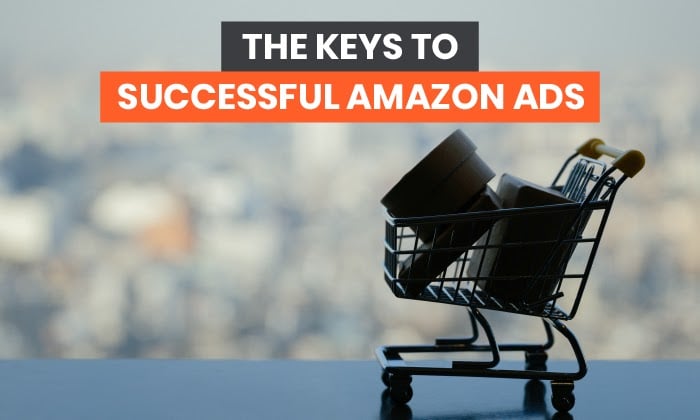
In one 36-hour period, Amazon sold 100 million products. Chances are, Amazon ads spurred some of those sales.
Amazon ads allow companies to pop to the top of search results. You reap a return on your investment in the form of enhanced sales and potential customer loyalty. Amazon, in return, makes a profit on ad sales (to the tune of $3 billion in some years).
Creativity, including visual pizazz, is critical in the Amazon marketplace. Killer keyword strategies matter too.
I’ll walk you through Amazon ad setup best practices, so you’ll know just what to do to get your products flying off the shelves.
Why Your Business Should Use Amazon Ads
The average user spends less than 10 minutes on Amazon. If your product is buried low in search results, no one will see it.
People simply don’t have the time to read every product description or check out every brand. We have jobs and kids and life pulling on our attention. We need to make decisions quickly.
Think of Amazon ads as your go-to method for cutting into a long line and grabbing attention.
Jump from spot 10 (oblivion) to spot 1, and you could increase your Amazon sales. Your investment could ensure that busy shoppers find your products before they’re ready to sign out.
That could mean more products sold and higher revenue.
More than 80 percent of brands get a 4x return on investment for their work on Amazon. If it’s worked for others, it could work for you.
What Are the Amazon Ad Types?
Rather than patiently waiting for customers to find them, companies use Amazon ads to get seen right now.
Amazon ads come in several types.
Sponsored Product Amazon Ads
These ads highlight just one item in your catalog. They appear within search results, but they pop to the top of the page. Consumers see them before anything else. If the screen is small enough, sponsored product ads are all consumers will see.
Sponsored Brand Amazon Ads
These ads allow you to feature several items from your catalog. They show up at the top of Amazon search results in a banner.
Often, Sponsored Product and Sponsored Brand ads work together. Check out this search result for “baby care.” A sponsored brand banner for WaterWipes starts the page, but Seventh Generation has an ad down below.
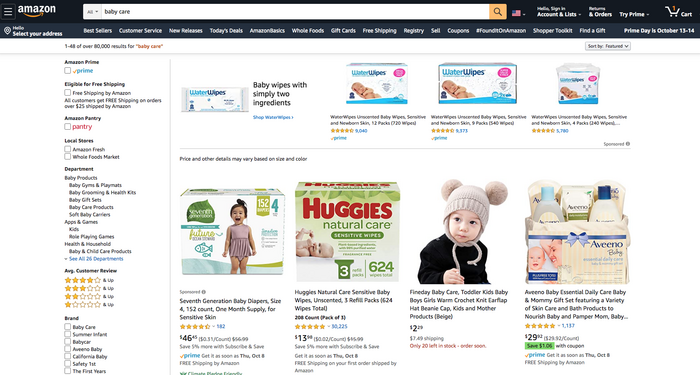
Sponsored Display Amazon Ads
With these ads, you can feature just one product and appear on websites Amazon owns or has a relationship with.
If a pesky Amazon ad for a product languishing in your shopping cart seems to follow you from website to website, you’ve encountered a Sponsored Display ad.
They may seem annoying, but they can be remarkably effective. More than 70 percent of shoppers click on ads like this while browsing the web.
What’s the Difference Between Display and Other Amazon Ads?
Sponsored Brand and Sponsored Product ads both appear on Amazon. Search for something, and they’ll pop up. Sometimes, buyers see more than one at the same time.
Sponsored Display ads are different. They appear on other websites Amazon either owns outright or has an affiliation with.
For example, plenty of bloggers make money by renting ad space to Amazon. They plug products in blog posts with Amazon affiliate links, or they run ads alongside the text.
Any Amazon ad that appears on a blog like this is a Sponsored Display ad. If you’d love to reach consumers who don’t spend all day on Amazon, this could be a smart approach.
Other Amazon Ad Types
Some Amazon ads are easy to spot, like this brand ad for ASUS at the top of a category search for electronics.
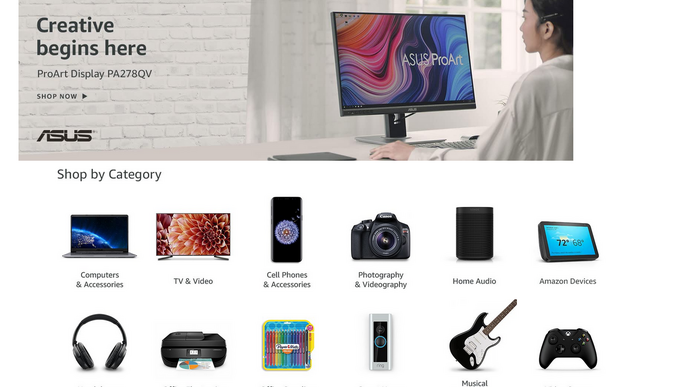
Some ads look similar to organic search results. They’re only identified by the tiny word “sponsored” somewhere inside the ad.
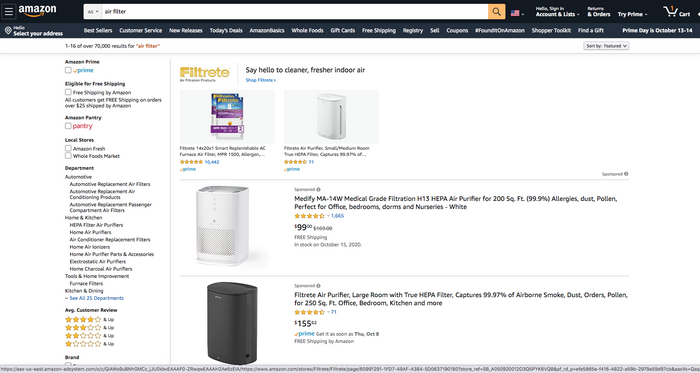
Here’s the best part: Someone scrolling quickly may miss that tiny indication and assume your product is simply the best one available.
Lockscreen Ads
Amazon also allows you to place lockscreen ads on kindle e-readers and tablets. This is based on the users’ interests on Amazon and reading history on Kindle.
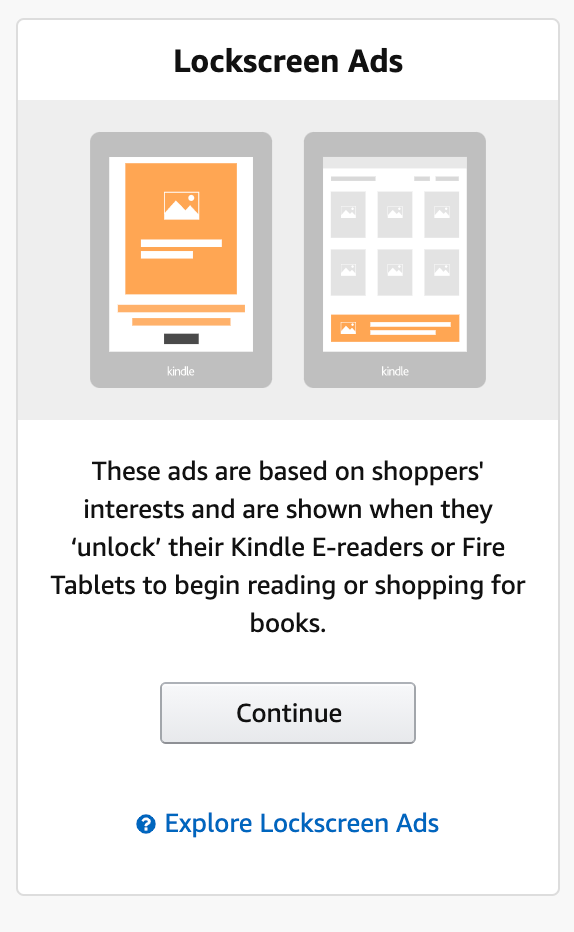
How to Create Amazon Ads
Whether you’re promoting a specific product or a suite of products, Amazon ad creation steps are mostly the same,
I’ll give you a very high-level overview of the ad-making process here. I’ll move quickly, but don’t worry. I’ll describe ad optimization in detail later in this article. This section works as a quick how-to for those who like to follow along while reading.
Check Your Eligibility
For any product you sell, you must complete a quick eligibility check before creating your ad. If you’re selling a product no one else offers (like a self-published book), this step is a snap. But if you’re selling something many others offer (like a brand-name antacid), verification might take longer.
Imagine you’re an Amazon shopper searching for a brand-name work shoe. You find the color and size you like, and you hit a page that looks like this. The critical part sits off to the right. Notice the “Add to Cart” and “Buy Now” buttons?
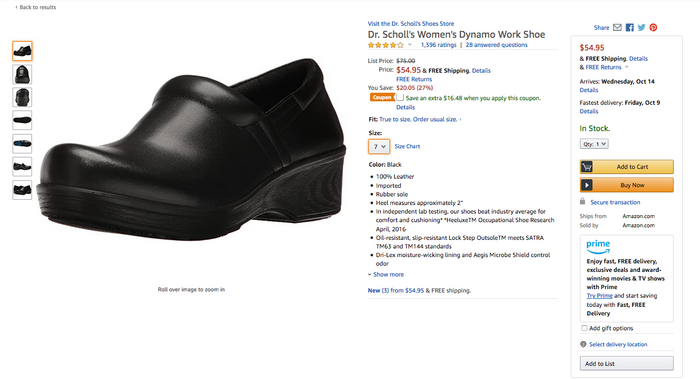
The vendor that owns the destination for the click owns the so-called “Buy Box.” This is also called “winning” the Buy Box. You must be that vendor to run a product ad.
If you’re winning the Buy Box, customers that hit “Add to Cart” on this page will buy from you. If you’re not winning this box, your competitor can run product ads, but you can’t.
If you’re the only vendor selling a product, you own the Buy Box by default, and you need to do no work at all. But if you’re in a crowded field, you’ll need to compete to win.
Keep your price low, always ship on time, and earn excellent reviews. Higher scores capture Amazon’s attention and make a Buy Box win more likely.
Log Into Amazon Ads Campaign Manager
Once you log onto Amazon Advertising, choose an ad type: Sponsored Products or Lockscreen Ads.
Remember that the Sponsored Product and Sponsored Display options allow you to promote just one product. If you’re ready to talk about an entire suite of items, choose the Sponsored Brand option.
Choose Your Products for Amazon Ads
Every promotion starts with a product. What items resonate with your audience? What products are clogging up your stockroom shelves? Take your time choosing the focal point for your ad.
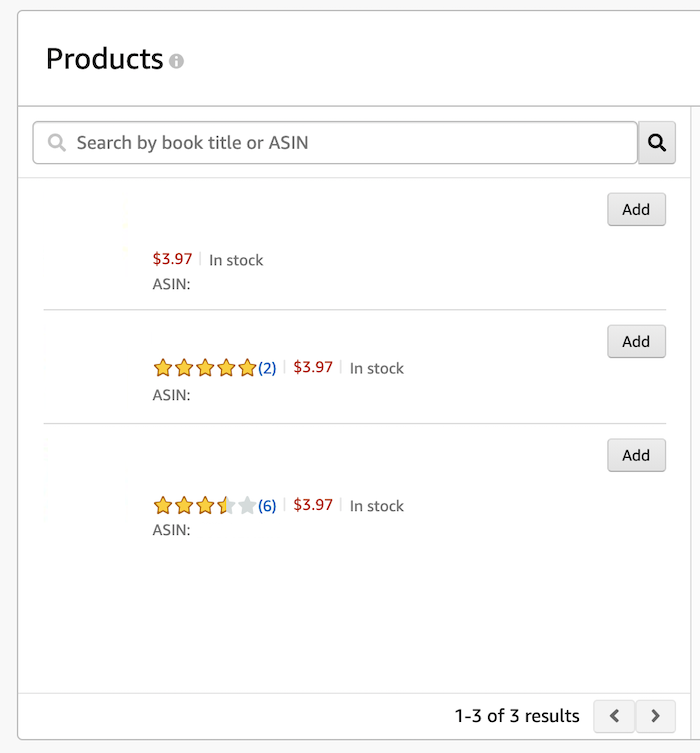
Set Your Specifics
Now we’re into the nitty-gritty of ad development.
Your campaign will hold all of the ads for a specific product, and it needs a creative name. If you’re successful with Amazon ads, you’ll have dozens of campaigns running all at once. Choose a name you’ll remember.
Next, set a budget for your campaign. The number you choose represents the top-end of your monthly bill, so don’t select something you can’t afford.
Finally, determine the start and stop dates for your campaign.
Choose Your Targeting
You have two options here: manual and automatic. With automatic, you are asking Amazon to find buyers based on keywords scraped in your product listing, or type in keywords that should trigger your ad.

Keywords play a crucial role in Amazon, just as they do in Google.
Tips for Choosing Your Amazon Ad Target Keywords
Keywords are the terms people type into search boxes when looking for products just like yours. They’re critical to your success.
The ideal Amazon keyword has three main attributes:
- Specific
- Popular
- Moderately expensive
You probably know what words describe your product. If you’re using Google Ads, your reports tell you all about the terms consumers use to find you. If you’re running a website, Google Search Console has similar reports. Dig into that data to find the words that already work.
If you don’t have internal data to mine, use a keyword research tool. Insights you gain here could help you understand what words you simply must have in ads and product descriptions.
Popular, common keywords can be expensive. If you have a tight budget, and you can’t pay $5 per click for the keyword “best baby diaper,” but you can pay $2 for “great diapers,” your choice is clear.
Decide Amazon Ad Format
Amazon offers two formats. The first is custom, where you write concise product copy for the ad. You can only do this for one product per ad campaign.
Ad copy creation begins with ideal product descriptions. Your ad copy should describe one or two essential benefits, but know your shoppers will head to your page to find out more about why they should choose your product.
Ensure your ad copy and your product descriptions knit together to showcase your brand in the best light.
The other ad option is a standard ad. This is an ad without custom text, but your products’ titles and descriptions still play a role.
How to Optimize Your Amazon Ads
Blend your very best writing and photography into an irresistible, clickable morsel, and you’ve created an exceptional promotion.
Typically, ads are based on your Amazon product listing. Make your products as enticing as possible to ensure your ads work.
Your primary image options are restricted. Amazon requires that you showcase your product on a white background. You can’t include anything that doesn’t come standard with the product, and you can’t use flashy techniques to make the photo pop.
Focus on getting a crisp, clean shot of the product. Showcase features, if you can, get creative with camera angles to show off all the benefits, and make sure everything is in focus.
Taking exceptional e-commerce photos can be challenging. You want to showcase your creativity and photography skills, but rules and regulations limit you. Take your time with this step. Your photos can make or break a sale.
How Much Do Amazon Ads Cost?
Pricing structure involves interplay between three key factors: keywords, competition, and clicks.
- Keywords are the terms that describe your brand, your product, or both. You select them, or you allow Amazon to choose them for you.
- Competition refers to the number of companies or brands that also want your keyword. The more players, the higher the price.
- Clicks involve a user expressing interest in your brand.
keyword price × number of clicks = your final cost
You’ll set a bill ceiling, so you won’t keep racking up charges indefinitely. At some point, you’ll spend all the money you’ve agreed to spend. Automatic targeting, which uses keywords and product types to automatically determine where your ads appear. You can set bids based on a default or what Amazon recommends.
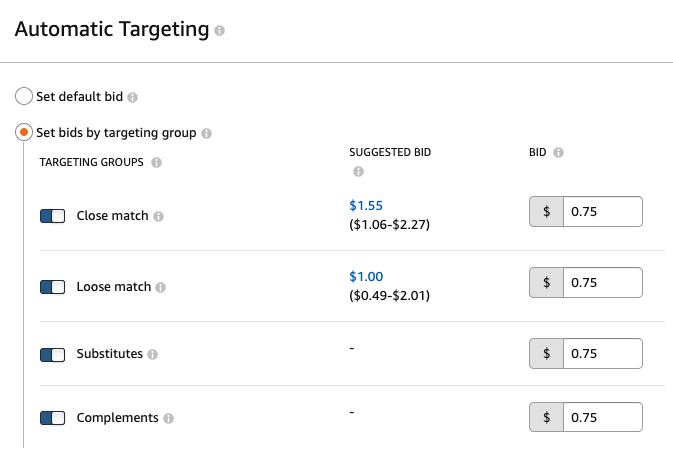
On average, companies spend between 50 cents and 1 dollar to nail down just one click. Amazon lets you set monthly budgets as low as $5. You can pause or cancel your ads too, and you won’t face cancellation fees.
Most advertisers keep lean Amazon ad budgets. They dedicate less than a quarter of their total annual ad budgets to Amazon.
Conclusion
People come to Amazon every day to find out more about products and brands just like yours.
You could let them try to find you organically, but crossing your fingers, closing your eyes, and hoping for clicks isn’t a winning strategy.
Instead, you must put your items in front of people. You have to get there before they spend their money.
I’m a big believer in Amazon ads. I hope I’ve made you a believer too.
Have you used Amazon ads before? How well did they work for you?
The post The Key to Successful Amazon Ads appeared first on Neil Patel.
from Blog – Neil Patel https://ift.tt/3mpMjcl
via IFTTT
